Cats are beloved pets known for their independent nature and mysterious demeanor. While cat owners appreciate their feline companions, one common challenge they face is dealing with cat shedding. Cat shedding occurs naturally as cats shed most of their hair twice a year, typically in spring and fall. However, cat shedding management should be practiced by many cat owners.
To tackle the issue of cat shedding, it is important to understand the causes and implement effective management techniques. By following these tips and tricks, you can reduce cat shedding and keep your home cleaner and more comfortable for both you and your furry friend.
Key Takeaways:
- Regular brushing is the most effective way to reduce cat shedding.
- A healthy diet rich in proteins and essential fatty acids improves the condition of your cat’s skin and coat.
- Proper hydration is crucial for maintaining a healthy coat and reducing shedding.
- Creating a calm and stress-free environment for your cat helps manage shedding.
- Designating a fur-friendly space for your cat can help contain shedding to a specific area.
Understanding Cat Shedding and Causes
Cats naturally shed their hair as part of their hair growth cycle. This shedding process is influenced by changes in daylight known as the photoperiod. Outdoor cats typically experience shedding twice a year, during the spring and fall seasons. This shedding season is triggered by the changing length of daylight hours.
On the other hand, indoor cats may shed throughout the year due to the controlled temperature and artificial lighting in their environment. The absence of natural seasonal cues can cause indoor cats to shed constantly.
Excessive or unusual shedding can be a sign of an underlying health issue. If your cat is shedding excessively or you notice any changes in their shedding patterns, it is important to seek veterinary assistance. A veterinarian can help determine if there are any underlying health concerns contributing to your cat’s shedding.
The image above depicts a cat shedding its fur, illustrating the natural process of shedding that cats go through. Understanding the causes and patterns of cat shedding can help you manage it more effectively.
Grooming Techniques for Cat Shedding Management
Regular grooming is essential to minimize cat shedding and maintain a healthy coat. Whether your cat has long or short hair, incorporating regular brushing sessions into their grooming routine can significantly reduce shedding. Long-hair cats benefit from several brushing sessions a week, while short-hair cats can be groomed once a week.
To effectively remove loose fur and prevent matting, it is important to use the right grooming tools. A metal comb with fine to medium teeth is ideal for gently detangling and removing loose hair from your cat’s coat. Alternatively, a rubber curry shedding brush can be used to massage the skin and collect loose fur.
For shorthaired cats, a grooming glove can be particularly effective in removing loose fur. Simply put on the glove and stroke your cat’s coat in the direction of hair growth to collect loose hair. The textured surface of the glove helps to trap and remove shedding fur, making it a convenient and comfortable grooming tool.
When grooming your cat, it is important to avoid using metal de-shedding tools or rakes, as they can potentially damage the hair and skin. Stick to gentle grooming techniques and tools to ensure a positive grooming experience for your furry friend.
Importance of Cat Hydration and Diet
Proper hydration is crucial for maintaining a healthy coat and reducing shedding in cats. Just like humans, cats need to drink an adequate amount of water to stay hydrated. Dehydration can lead to dry skin and a dull coat, resulting in increased shedding.
One way to ensure your cat stays well-hydrated is by incorporating wet food into their diet. Wet food contains a higher water content compared to dry kibble, helping to increase their overall water intake. It is important to note that while wet food can contribute to cat hydration, fresh water should still be readily available to them at all times.
Aside from hydration, a high-quality diet is essential for promoting a healthy coat and reducing shedding in cats. Look for cat food that is rich in proteins, essential fatty acids, and vitamins. These nutrients play a crucial role in maintaining healthy skin and coat. Omega-3 and omega-6 fatty acids, which can be found in fish oils, are particularly beneficial for reducing shedding.
Consulting with a veterinarian is vital to ensure your cat’s diet meets their specific nutritional needs. They can provide guidance on choosing the right cat food and any necessary supplements to promote a healthy coat and overall well-being.

Minimizing Stress for Shedding Control
Excessive shedding in cats can often be a result of stress or anxiety. It is essential to create a calm and stress-free environment for your feline friend to effectively manage shedding. Here are some tips to help minimize stress and promote a healthier coat:
- Provide hiding spots: Cats need a safe space where they can retreat and feel secure. Consider creating hiding spots using cat furniture, blankets, or cardboard boxes to give them a sense of security.
- Interactive toys and scratching posts: Engaging your cat with interactive toys and providing them with scratching posts can help relieve stress. These activities provide mental and physical stimulation, reducing anxiety and promoting a calmer environment.
- Use pheromones: Pheromones are natural chemicals that cats release to communicate and mark territory. Synthetic pheromone products, such as diffusers or sprays, can help create a calming effect and reduce stress-related shedding.
- Give your cat space: Cats are independent creatures and need their personal space. Ensure they have access to areas where they can be alone and undisturbed. Designating a cat-only zone where they can retreat when they feel overwhelmed can significantly reduce their stress levels.
In addition to these measures, it’s also important to monitor your cat’s behavior and address any potential sources of stress. A calm environment and reduced stress levels will not only help manage shedding but also contribute to your cat’s overall well-being.
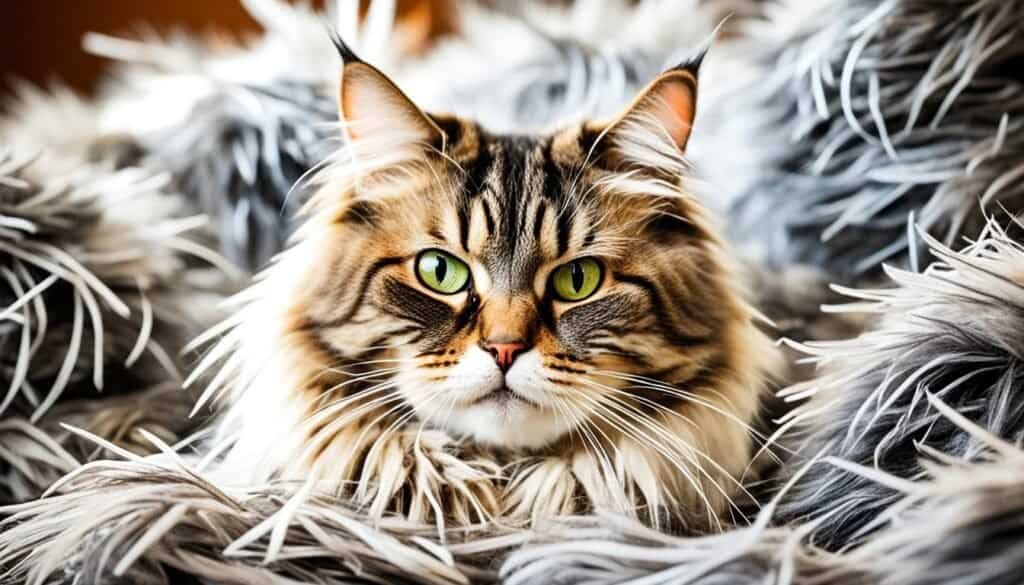
Creating Fur-Friendly Spaces
When it comes to managing cat shedding, designating a specific area for your furry friend can make a big difference. By creating a designated shedding spot, you can contain the fur to a smaller area, minimizing the amount of hair that ends up on your furniture and belongings.
Start by choosing a designated area in your home that is comfortable for your cat. Consider placing a cozy bed and a cat tower in this spot to provide a comfortable and enticing environment. Cats love having their own spaces, and these additions will make the designated area even more appealing.
To help collect shedding fur, place a soft blanket or towel in the designated area for your cat to lie on. The blanket or towel will act as a magnet for loose fur, trapping it as your cat sheds. Regularly washing the blanket will remove the hair and keep the area clean.
Creating a fur-friendly space not only helps manage shedding but also provides your cat with a sense of security and comfort. Having a designated area where they can relax and unwind will reduce stress and promote overall well-being.
When to Seek Veterinary Assistance
Excessive shedding in cats can sometimes indicate underlying health concerns. If you notice that your cat is shedding more than usual, it is important to seek veterinary assistance to ensure their well-being. Excessive shedding can be a result of various factors, including allergies, infections, poor diet, and stress.
A veterinarian will be able to assess your cat’s condition and determine if there is an underlying health issue contributing to the excessive shedding. They can conduct a thorough examination, review your cat’s medical history, and perform any necessary tests to diagnose any underlying conditions accurately.
Once a diagnosis is made, your veterinarian can provide appropriate treatment options tailored to your cat’s specific needs. This may involve medication, dietary changes, or other interventions to address the underlying condition and alleviate excessive shedding.
Regular check-ups with a vet are crucial to ensure your cat’s overall health and well-being. These check-ups allow for early detection and prevention of potential health concerns, helping to minimize the risk of excessive shedding caused by underlying conditions.
By seeking veterinary assistance when needed, you can ensure that your cat’s health concerns are addressed promptly, promoting a healthier and happier life for your feline friend.
Conclusion
Managing your cat’s shedding is an important part of cat care. By implementing proper cat shedding management techniques, such as regular grooming, a healthy diet, stress reduction, and ensuring proper hydration, you can effectively control shedding and maintain a cleaner and happier household.
Regular brushing is key when it comes to reducing cat shedding. This helps remove loose fur and prevents matting, promoting a healthier coat. Additionally, providing your cat with a high-quality diet that contains essential nutrients, proteins, and omega-3 and omega-6 fatty acids will contribute to a healthier coat and reduced shedding.
Minimizing stress and creating designated fur-friendly spaces can also help manage shedding. Providing your cat with a calm environment, interactive toys, and a cat-only zone can alleviate stress and ultimately reduce shedding. Furthermore, maintaining proper hydration by incorporating wet food into your cat’s diet will ensure a healthy coat and decreased shedding.
If your cat experiences excessive shedding, it’s important to seek veterinary assistance to rule out any underlying health issues. Allergies, infections, poor diet, or stress can contribute to excessive shedding, and a professional diagnosis can help address these concerns. By following these cat shedding management tips, you can provide the best care for your feline companion and maintain a harmonious living environment.
FAQ
How often do cats shed their hair?
What is the best way to reduce cat shedding?
What tools should I use to manage cat shedding?
How can I improve my cat’s coat condition and reduce shedding through diet?
Can stress affect cat shedding?
How can I create a designated space to contain shedding?
When should I seek veterinary assistance for excessive shedding?
How can I effectively manage cat shedding?
Last modified: February 25, 2024

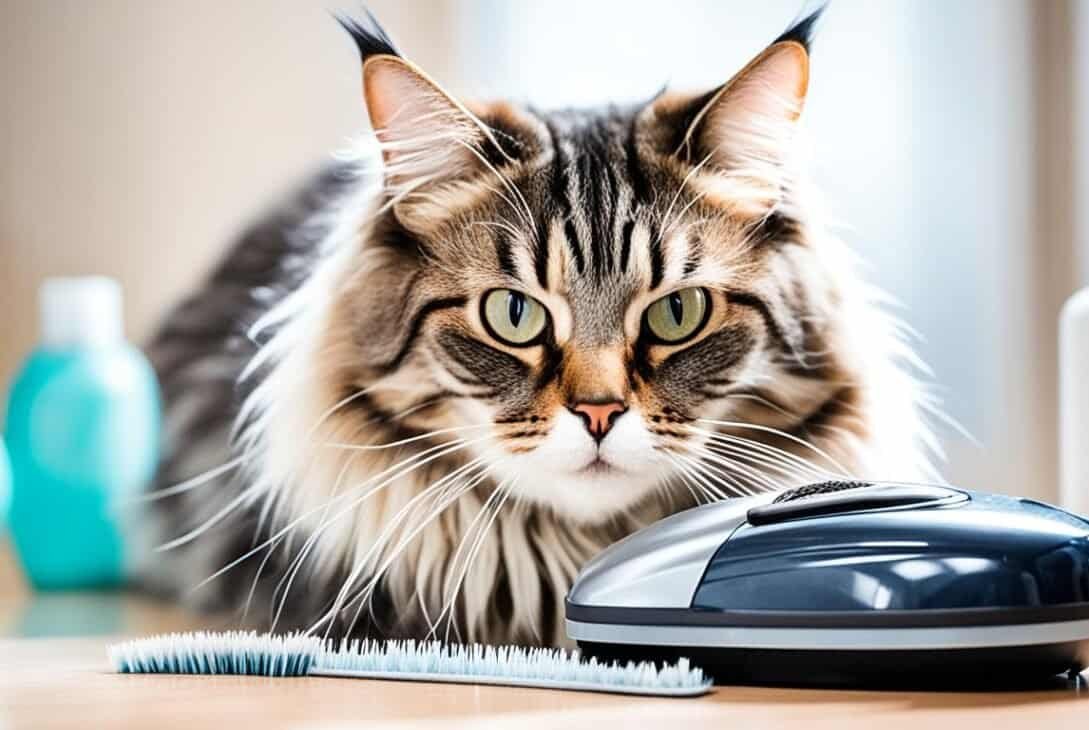


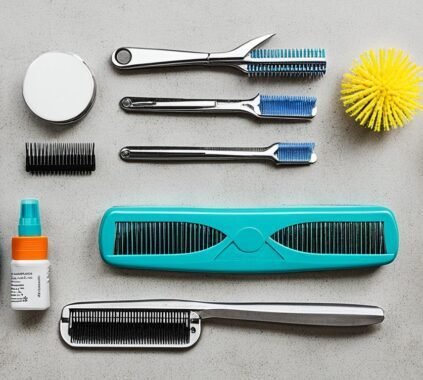
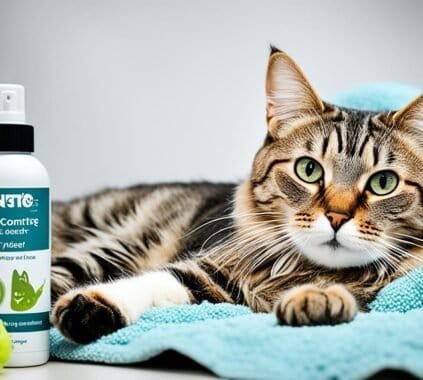

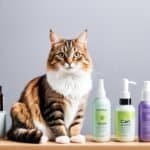
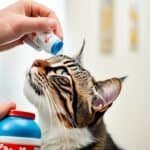





[…] brushing is essential for preventing hairballs in cats, especially for long-haired breeds. Brushing helps remove loose hair and prevents excessive fur […]
[…] the Furminator Short Hair deShedding Tool is a wise choice for cat owners who want to effectively manage their cat’s shedding and maintain a clean and healthy environment. Regular use of this top-rated cat grooming equipment […]
[…] a safe and effective flea and tick preventative is essential for your cat’s […]
[…] your cat’s nails is an essential part of their grooming routine. It helps keep their claws at a comfortable length, prevents […]
[…] role in maintaining the health of your cat’s eyes. A high-quality, high-protein diet is essential for cat eye health. Protein provides the building blocks for various tissues, including the photosensitive […]